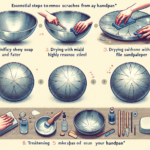Music has long been celebrated for its power to heal and soothe the human soul. Among the various instruments that have been used for relaxation and meditation, the handpan stands out for its unique, ethereal sound that can transport listeners to a state of deep calm and tranquility. The handpan, also known as the hang drum, is a relatively new musical instrument that has captured the hearts of many for its ability to evoke profound emotional responses. In this article, we will explore the healing tones of the handpan and the deep relaxation techniques it can facilitate.
What is a Handpan?
The handpan is a steel drum-like instrument that was invented in the early 21st century. Its distinctive design consists of a convex steel shell with a series of tone fields hammered into its surface. Played by hand, the instrument produces soothing, resonant tones that can range from meditative drones to complex rhythms. The handpan is often tuned to specific scales, each with its unique mood and emotional quality.
The Science of Sound and Relaxation
Sound has a profound impact on the human body and mind. Research has shown that certain frequencies and rhythms can influence brain wave activity, heart rate, and respiratory patterns. When we listen to relaxing music, such as the tones produced by the handpan, our brain waves can shift from the fast-paced beta waves associated with alertness to the slower alpha and theta waves associated with relaxation and meditation.
This shift in brain wave activity can trigger the body’s relaxation response, leading to decreased blood pressure, reduced stress hormones, and a sense of overall well-being. The rhythmic, melodic qualities of the handpan make it an ideal instrument for promoting deep relaxation and mental clarity.
Deep Relaxation Techniques with the Handpan
The therapeutic potential of the handpan can be harnessed through various deep relaxation techniques. Here are some methods that leverage the healing tones of this unique instrument:
Guided Meditation
Guided meditation involves following a set of instructions from a meditation guide or recording, accompanied by the soothing sounds of the handpan. The melody of the handpan can help to focus the mind, making it easier to follow the meditation and achieve a deeper state of relaxation. Some guided meditations may involve visualization exercises, breathwork, or body scans, all enhanced by the calming tones of the handpan.
Sound Baths
A sound bath is a therapeutic session where participants are enveloped in a “bath” of sound waves produced by various instruments, including the handpan. During a sound bath, participants typically lie down, close their eyes, and let the sound waves wash over them. The resonance of the handpan can create a sense of spatial awareness and emotional release, promoting profound relaxation and mental clarity.
Personal Play
One of the most direct ways to experience the healing power of the handpan is to play it yourself. The tactile and auditory feedback of playing the handpan can be a meditative practice in itself. Focusing on the rhythm and melody you create can help to quiet the mind and bring you into the present moment. Even simple, repetitive patterns can have a powerful calming effect.
Breathwork with Handpan
Breathwork involves conscious control of your breathing pattern to achieve specific emotional or physical benefits. Combining breathwork with the handpan can enhance the relaxation effects. For instance, taking deep, slow breaths in sync with the handpan’s rhythm can help to deepen your relaxation and elevate your mood. This practice can be particularly effective for reducing anxiety and stress.
Mindfulness Practice
Mindfulness involves staying present in the current moment and observing your thoughts, feelings, and sensations without judgment. The soothing, repetitive sounds of the handpan can serve as a focus point, anchoring your awareness and making it easier to stay present. This can be a highly effective technique for reducing mental chatter and achieving a state of deep relaxation.
Conclusion
The handpan is a remarkable instrument whose healing tones have captivated many. Its unique sound has the potential to bring about profound relaxation and mental clarity through various techniques such as guided meditation, sound baths, personal play, breathwork, and mindfulness practice. Whether you are a musician or simply a lover of sound, the handpan offers an accessible pathway to deep relaxation and emotional well-being. By integrating the handpan into your relaxation routine, you can harness its therapeutic power to enhance your mental and emotional health.
Frequently Asked Questions (FAQs)
-
What is the origin of the handpan?
The handpan was developed in the early 21st century, specifically in 2000, by Felix Rohner and Sabina Schärer in Switzerland. It was initially introduced as the ‘Hang’ and has since inspired the creation of various similar instruments globally.
-
Is it difficult to learn how to play the handpan?
The handpan is considered relatively easy to play compared to other musical instruments. Its intuitive design allows players to produce pleasing sounds with little formal training. However, mastering complex rhythms and techniques still requires practice and dedication.
-
Can I use a handpan in a group meditation session?
Absolutely! The handpan is an excellent addition to group meditation or yoga sessions. Its soothing tones can enhance the overall atmosphere and help participants achieve a deeper state of relaxation.
-
Where can I buy a handpan?
Handpans can be purchased directly from individual makers, specialized music shops, and online marketplaces. However, due to high demand and the artisanal nature of handpans, they can be quite expensive and have long waiting lists.
-
Can children use the handpan for relaxation?
Yes, children can benefit from the calming sounds of the handpan. Its easy playability also makes it suitable for younger users. However, supervision is recommended to ensure the instrument is handled with care.





